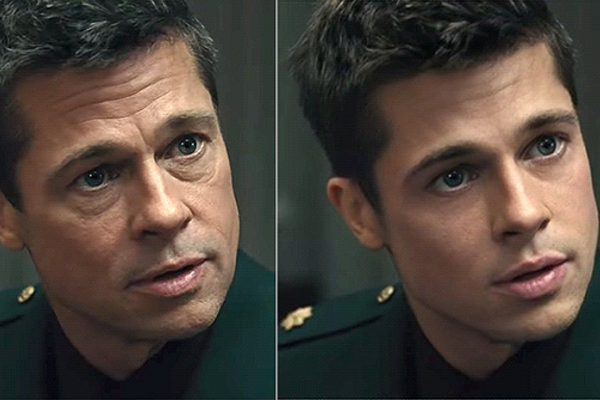In films and television shows, de-ageing mechanism is used to make the actors look younger. It is mostly used in cases of flashback scenes. A blend of good CGI and overlaying methods give new life to the flashback scenes. Older actors have achieved a whole new life and sea of opportunities where they can play twenty years younger than their actual age.
With the advancement of de-ageing, VFX for films continues to give new opportunities to the makers every single day.
Going back in time: De-ageing with VFX
If you notice the pattern of actors acting in Bollywood and Hollywood, the thirst for old and classic actors never dies. Brad Pitt has worked with three generations of actresses and still sells more tickets than any of them individually can.
Shah Rukh Khan was able to play 20 years younger than him distorted looking man (Fan, 2016) and even a young adult dwarf with much slimmer body features (Zero, 2018). This was all made possible with the use of De-Ageing technique in VFX.
The multimillion-dollar business of films starring de-aged versions of Will Smith, Brad Pitt and Chris Evans tells us a lot about the value of the same. People would rather pay a hundred crores to watch a de-ageing induced Shah Rukh Khan than an art film with an upcoming actor.
In the flashbacks scenes of Captain America, Chris Evans was showed to be a teenager rookie soldier when he was actually over 40 years old.
When did it all begin?
Disney first explored the idea of getting an actor to play against himself for Gemini Man almost two decades ago, but the technology was nowhere near advanced enough.
The use of prosthetics and makeup manipulation was the only resort makers had before VFX could be improvised to such an extent. Bollywood films, to this day, cast other actors to play flashback versions where their facial features are completely different. These are minute detailing things where Hollywood takes the crown for genuine filmmaking.
Redefining Storytelling with De-Ageing
Robert De Niro and Al Pacino were digitally de-aged to portray younger versions of hitman Frank Sheeran and Teamsters boss Jimmy Hoffa, respectively in ‘The Irishman‘.
‘The Irishman’ became a mainstream and cult favorite over Netflix. The astounding film making was the first thing getting appreciated when the biggest legends of cinema were on the screen being mafias. Now sure, the director could have placed younger actors with similar facial features to play their younger versions.
However, that would have stolen the essence of the actual characters (like it is actually done in most Bollywood films with flashback scenes). Released in 2020, Love Aajkal starring Sara Ali Khan and Karthik Aaryan showed Karthik Aaryan playing the younger version of Randeep Hooda.
Most film critics said that Randeep Hooda could have played his younger version himself making the flashback scenes look more authentic.
The same mistake was done in its prequel released in 2009 where Saif Ali Khan played both himself and Rishi Kapoor’s younger flashback.
Extension to the Legends of Cinema
De-ageing is giving away for actors to extend their careers – and directors are sure to welcome such experience made newly available. The idea of us watching our favorite legends does get limited by their age and their role choices in films.
Marvel Cinematic Universe (MCU) is nowhere behind when it comes to de-ageing their favorite superheroes. A skinny and teenage Chris Evans was the talk of the town for years. People even asked Evans on his ‘Captain America: The First Avenger’ promotions as to what diet he had followed to look that skinny.
Other than Captain America; MCU characters Nick Fury and Phil Coulson, get de-aged by 25 years by Lola Visual Effects for Captain Marvel.
However, it really is necessary to realize how de-ageing helps bring the most realistic cinema on our screens. The craft of de-ageing and its implementation in VFX for films is going to revolutionize cinema.
More production studios should be geared on to hire experts who can use this technique. Quality cinema is the way to go.

